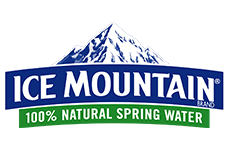Ice Mountain (water) facts for kids
 |
|
 |
|
| Market | Midwestern United States |
|---|---|
| Produced by | BlueTriton Brands |
| Introduced | 1987 |
| Type | Still |
| pH | 7.9-8.2 |
| Bromine (Br) | 0.014-0.02 |
| Calcium (Ca) | 45-80 |
| Chloride (Cl) | 1.1-6.6 |
| Fluoride (F) | 0-0.32 |
| Manganese (Mn) | 0 |
| Magnesium (Mg) | 16-31 |
| Nitrate (NO3) | 0 |
| Potassium (K) | 0-1.3 |
| Sodium (Na) | 2.5-6.4 |
| Sulfate (SO4) | 10-16 |
| TDS | 170-310 |
| All concentrations in milligrams per liter (mg/L); pH without units | |
Ice Mountain is a popular brand of bottled water. It comes from BlueTriton Brands. This water is mainly sold in the Midwest part of the United States.
The brand started in 1987 with PepsiCo. It was later sold to Perrier in 1989. From 1992 to 2021, Nestlé owned Ice Mountain. Since 2002, the water has come from underground springs. These springs are in Mecosta County and Evart, Michigan. The water is pumped from these springs. It is then bottled at a factory in Stanwood, Michigan.
Contents
The Story of Ice Mountain Water
Early Beginnings in Maine
The history of Ice Mountain water goes back a long way. It started in 1857 in Rumford, Maine. A landowner named Dexter Abbott began selling water. He collected it from Moon Tide Spring. This spring was on Mount Zircon.
The Moon Tide Spring business was connected to another famous water brand. This was Poland Spring, owned by Abbott's relatives. People advertised Mount Zircon Spring Water. They said it had health benefits.
PepsiCo Takes Over
In January 1987, PepsiCo bought the Mt. Zircon Company. They created a new company called Great Spring Waters of America. The Wall Street Journal reported the sale was for less than $10 million.
PepsiCo improved the bottling factory. They also added new testing equipment. At first, they found some water wasn't clean enough. So, they recalled some bottles. These bottles were shipped before mid-April 1987.
On May 12, 1987, PepsiCo announced something new. They would sell water from Moon Tide Spring. This water would be under the new Ice Mountain Maine Spring Water brand. Sales began in June in four New England cities. These cities were Boston, Hartford, New Haven, and Providence.
Changes in Ownership and Location
PepsiCo sold Ice Mountain to the Perrier Group of America. This happened on January 24, 1989. This meant Ice Mountain and Poland Spring had the same owner.
After Perrier bought the brand, bottling at Mount Zircon stopped. Ice Mountain water was then trucked to Poland Spring. It was bottled and sent out from there. In 1992, Nestlé bought Perrier. Soon after, Ice Mountain water came from Poland Spring instead of Mount Zircon. By 1993, a local newspaper noted that Rumford still produced water. But only a small team loaded trucks there.
In 1996, Ice Mountain changed its water source again. It moved to New Tripoli, Pennsylvania. Nestlé's Deer Park Spring Water also moved there. Bottling then happened at a new Perrier factory in Allentown.
Moving to the Midwest
By 2000, Ice Mountain was mostly sold in the Midwestern United States. Nestlé wanted to bottle the water closer to where it was sold. They drilled wells and tested sites in Wisconsin and Michigan in late 2000.
Some local people were worried about these plans. They thought taking too much water could harm the environment. This led to more rules about how much water companies could use. On May 10, 2002, Nestlé announced something important. They had started bottling Ice Mountain water in Mecosta County, Michigan.
In the early 2000s, Nestlé worked with Six Flags. They sponsored some log flume rides. These rides were at Six Flags Great America and Six Flags St. Louis. They were called "Ice Mountain® Splash."
Discussions About Water Use
Ice Mountain has been part of a big discussion. This discussion is about using water from the Great Lakes. Some people worry about taking too much water from the area.
In 2004, a Michigan court temporarily stopped the pumping of Sanctuary springs. Later, a higher court allowed pumping to continue. The company and local groups then agreed to pump less water. They decided on about 218 gallons per minute. This amount is similar to other local drink companies.
Nestlé faced similar concerns when looking for a new water source. This was near the White River in Michigan. In 2017, Nestlé asked for permission to pump more water. They wanted to increase it to 400 gallons per minute.
In 2019, a Michigan court made an important decision. It said that Ice Mountain's bottled water operation was not a necessary public service. It also said their bottled water was not a public water supply. This meant Osceola Township could say no to the company's plan. The company wanted a new pump station to move its water.
External links
- Official website: http://icemountainwater.com

